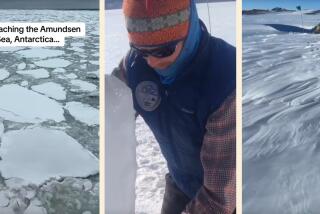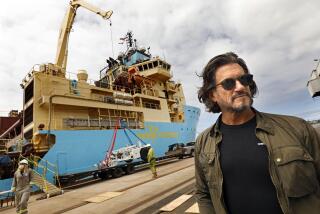Digging Earth’s Secrets From the Ocean Floor
- Share via
OFF THE NEW JERSEY COAST — Jerry Dickens hasn’t shaved in about a week.
In his white T-shirt, shorts and sandals, the 32-year-old chemist is plowing through another long day in a windowless chemistry lab below deck on the research ship called the JOIDES Resolution.
“You’re expected to work 12 hours,” Dickens says over the hum of his instruments and the machinery of the ship, which is rocking gently about 110 miles east of Atlantic City. “If you get excited by something, you spend 23 hours a day in here.”
And, indeed, he is hooked. He’s been analyzing water trapped in the sediment pulled up from about 2,000 feet below, and he’s baffled by what he and his colleagues have found.
Their observations--about a puzzling pattern in the waste left by bacteria--are part of a wealth of data that 27 scientists spend hours cramming into the shipboard computers.
At three sites off New Jersey during its monthlong expedition at sea, the Resolution drilled into the sea floor and pulled out columns of mud and sand, searching for clues about the ancient rising and falling of sea level.
It was the fifth voyage this year for the 471-foot JOIDES Resolution, a converted oil-drilling ship that has sailed for science since 1985.
JOIDES (pronounced JOY-DEEZ) stands for the Joint Oceanographic Institutions for Deep Earth Sampling, the international group representing the partners in the drilling program. The partners come from 20 countries, although the National Science Foundation supplies about 60% of the program budget.
The ship can reach down more than 5 miles to drill around the clock and recover columns of sediment that reveal geological history.
No other scientific vessel can get continuous cores of sediment stretching so deep into the ocean floor, says James Austin Jr., a senior research scientist at the Institute for Geophysics at the University of Texas at Austin.
“We create encyclopedias of the ocean,” he says, sweeping his hand past three bookshelves jammed with data from the ship’s voyages.
Some of those findings are extraordinary. In February, for example, scientists announced they’d found confirmation in the sea floor off Florida that a huge asteroid slammed into Earth 65 million years ago, a catastrophe blamed for killing off the dinosaurs.
The ship takes on a new scientific crew, usually about two dozen researchers, for each trip. They work in labs and offices spread over seven stories, connected by a maze of narrow hallways and stairways.
“They’re not being bothered by telephones, secretaries, students, all the things that disturb you back on land,” says Nicholas Christie-Blick of Columbia University’s Lamont-Doherty Earth Observatory, who was co-chief scientist with Austin for the expedition on sea-level changes.
“What you can accomplish in a month . . . is phenomenal,” Christie-Blick says.
“It’s our one and only shot to get this sort of data,” says Dickens, a researcher at both the University of Michigan and James Cook University in Townsville, Australia. “You want to be very sure you’ve done a good job. Once we leave the ship, that’s it. Other scientists will have to put their faith in what we’ve done out here.”
On this voyage, the ship delivered a slender, 30-foot-long column of sediment every half-hour to two hours. The samples were encased in a flexible plastic cylinder and cut into shorter chunks for easier handling. Each chunk was then split lengthwise, so half the sample could be sent to an archive and the other half used to look for microscopic fossils, chemical traits and other clues to the history of the ocean floor.
Laid out on a table one day during the trip, these half-cylinders looked like rain gutters clogged with dark, moist, olive-green mud. In one segment, the texture changed abruptly from creamy smooth to brick-like rough. That marks a time when erosion from the land suddenly picked up, washing the coarser sediments into the ocean.
Altogether, the ship recovered about 1,000 yards of mud and sand columns on this trip, revealing geological history from up to 35 million years ago.
And, already, there are some surprises. At one spot on the continental shelf about 60 miles off the coast, the drilling turned up bits of wood, pollen and fungal spores, rather than the fossils of ocean-going creatures. Apparently, a lagoon was there as long as 9 million years ago, says Christie-Blick, who’d thought the spot was submerged under at least dozens of yards of water until a few million years later.
Then there’s the mystery Dickens and his colleagues turned up in sediment from another hole.
They were looking for waste left by bacteria that munch on organic matter from decaying plants and animals. The more waste, the better the bacteria have been eating.
The scientists found that over the last half-million years, the amount of waste from bacteria has gone up and down repeatedly, rather than following the gradual change scientists usually see. In fact, it seems to follow changes in climate: lots of it during warm periods, much less during ice ages.
“Three days ago, we’d never seen anything like this before,” Dickens says.
What’s going on here, and what does it mean? During the warm periods, did great feasts of organic matter drop on the ocean floor like manna as tiny phytoplankton died, or get swept in from the land by rivers and ocean currents? Or does the pattern mean instead that the population of bacteria waxed and waned with the climate? In fact, is Dickens seeing the waste from ancient meals or recent ones?
“Over the next couple years,” he says, “we can figure it out.”






